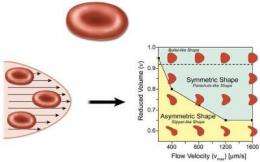Slipper-shaped blood cells

Red blood cells, which make up 45 percent of blood, normally take the shape of circular cushions with a dimple on either side. But they can sometimes deform into an asymmetrical slipper shape. A team of physicists have used simulations to explore how fluid flow might be responsible for this deformation, as well as how the deformation in turn affects blood flow. The insights could help understand the mechanisms involved in arterial disease and other blood flow-related ailments. Their research is reported in Physical Review Letters and highlighted with a Viewpoint in the October 26 issue of Physics.
When a red blood cell flows through an artery, one face usually balloons out like a parachute, but sometimes the cell can deform to resemble a slipper. To find out why, Badr Kaoui at the Université Joseph Fourier in Grenoble, France and his colleagues modeled the cells as two-dimensional fluid-filled sacks flowing in a liquid. They found that when the cells weren't sufficiently plump, the symmetric parachute collapsed into a slipper. They also found that this morphing helped the sacks catch up with the rest of the fluid, suggesting that the slipper shape achieves more efficient blood flow.
Little is known about how the shape of red blood cells could change how they transport oxygen or how they interact with chemicals in the body. More generally, understanding circulation is important to pathology of illnesses like coronary heart disease. The ailment, which develops when plaque obstructs blood flow in an artery, is the leading cause of death in the United States. Kaoui and his colleagues' research takes important first steps toward understanding the consequences of red blood cell shape and behavior on overall blood flow.
More information: Why Do Red Blood Cells Have Asymmetric Shapes Even in a Symmetric Flow? Badr Kaoui, George Biros, and Chaouqi Misbah, Phys. Rev. Lett. 103, 188101 (2009); Download PDF (free)
Source: American Physical Society
















